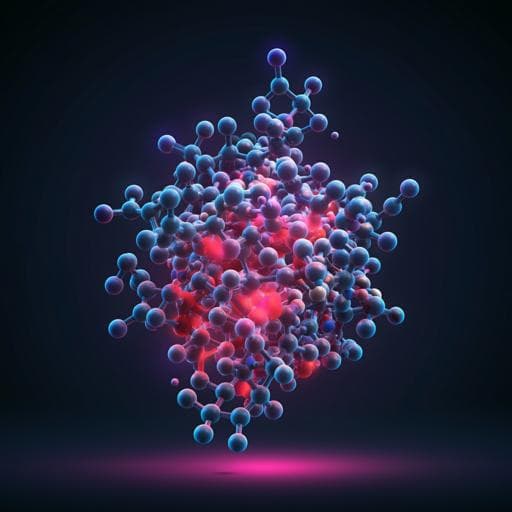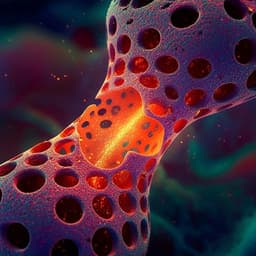
Chemistry
Efficient and versatile formation of glycosidic bonds via catalytic strain-release glycosylation with glycosyl *ortho*-2,2-dimethoxycarbonylcyclopropylbenzoate donors
H. Ding, J. Lyu, et al.
This groundbreaking research by Han Ding, Jian Lyu, Xiao-Lin Zhang, Xiong Xiao, and Xue-Wei Liu unveils a novel catalytic glycosylation method using glycosyl *ortho*-2,2-dimethoxycarbonylcyclopropylbenzoates, facilitated by a scandium(III) catalyst. The study highlights an innovative activation mode that efficiently constructs diverse glycosidic bonds, paving the way for advanced oligosaccharide synthesis.
~3 min • Beginner • English
Introduction
The study addresses the need for bench-stable, catalytically activable glycosyl donors that operate under mild conditions and are orthogonal to existing donor classes. Carbohydrates are central to diverse biological processes, driving demand for reliable, scalable methods to synthesize well-defined oligosaccharides and glycoconjugates. While many catalytic glycosylation methods exist, commonly used donors (e.g., fluorides, imidates, phosphates) can be moisture-sensitive and often require preparation immediately before use; classic thioglycoside donors need strong promoters and may cause side reactions. Glycosyl esters are stable but typically require superstoichiometric promoters and show limited scope. The authors hypothesize that embedding a donor-acceptor cyclopropane (DAC) within a glycosyl ester and activating it via Lewis-acid chelation to a 1,3-dicarbonyl motif would trigger ring-strain release, enabling selective anomeric activation through a non-covalent mode. The goal is to develop a broadly applicable, mild, orthogonal, catalytic glycosylation platform using glycosyl CCBz donors and a practical Sc(III) catalyst to efficiently forge O-, S-, and N-glycosidic bonds, including challenging linkages relevant to bioactive glycans such as chitooligosaccharides and Lipid IV fragments.
Literature Review
The paper situates the work within catalytic glycosylation advances: donors such as glycosyl fluorides, imidates, epoxides, and phosphates have enabled catalytic methods but often suffer from high reactivity, moisture sensitivity, and preparation constraints. Thioglycosides are stable and widely used, with variations enabling acid-catalyzed glycosylations, yet they frequently require strong promoters and can suffer aglycone transfer, especially under superacid conditions. Glycosyl esters (acetates/benzoates) are bench-stable but typically show mediocre reactivity and narrow scope unless bearing specialized leaving groups (e.g., pentenoates, ortho-(1-phenylvinyl)benzoates, heteroaromatic esters, allenoates); even then, few catalytic activations exist. Two catalytic activation modes for esters are discussed: (1) covalent activation (e.g., Tf2NH superacid catalysis) which can be harsh and induce side reactions; and (2) non-covalent activation through weak interactions at a distal activation site, exemplified by gold(I)-catalyzed glycosyl ortho-alkynylbenzoates, which suppress aglycone transfer but rely on expensive/toxic metals (Au, Ag, Hg). The authors also review DAC/DAB strain-release chemistry: DACs are high-strain, π-character species that undergo (intra/inter)molecular nucleophilic ring opening under Lewis-acid mediation, yet intramolecular variants and their use in glycosylation remain underexplored. Previous cyclopropane-fused glycosyl donors achieved selectivity control but did not provide an approach to natural sugar derivatives via catalytic strain-release. This work leverages DAC chemistry to create a new, non-covalent activation mode for glycosyl esters via a metallophilic 1,3-dicarbonyl anchor.
Methodology
Design and mechanism: The authors designed glycosyl ortho-2,2-dimethoxycarbonylcyclopropylbenzoate (CCBz) donors containing an intramolecular DAC. A chelatable Lewis acid (Sc(III)) coordinates to the two carbonyls of the 1,3-dicarbonyl, activating the adjacent cyclopropane for intramolecular nucleophilic ring opening by the benzoyl carbonyl. This generates an enolate and facilitates cleavage of the anomeric C–O bond to form an oxocarbenium ion, which reacts with the acceptor nucleophile. The resulting glycoside is deprotonated by the enolate, yielding a lactone leaving group and regenerating the Lewis acid, thereby closing a catalytic cycle. The enolate also scavenges protons, maintaining near-neutral conditions.
Donor synthesis: CCBzOH (ortho-2,2-dimethoxycarbonylcyclopropylbenzoic acid) is prepared on decagram scale (details in SI). Glycosyl CCBz donors are obtained by coupling anomeric hemiacetals with CCBzOH using EDC·HCl, DIPEA, and DMAP, affording amorphous, bench-stable solids with good solubility and thermostability.
Optimization: Model glycosylation between disarmed glucosyl CCBz donor 1a and cholesterol 2a was screened at rt in DCE or CH2Cl2 with 5 Å MS, 0.05 M. Sc(OTf)3 (10 mol%) gave product 3a in 96–99% yield with clean formation of the lactone leaving group (4, up to 99%). No reaction occurred without Lewis acid. Alternative Lewis acids (Bi(OTf)3, Zn(OTf)2, Ca(OTf)2/TBA PF6, B(C6F5)3) were inferior or inactive; TfOH gave complex mixtures. Catalysts for other donor classes (TMSOTf for imidates; Ph3PAuNTf2 for ortho-alkynylbenzoates) were ineffective, indicating orthogonal activation. 5 Å MS was critical; 4 Å MS reduced yields. CH2Cl2 performed best (up to 99% yield). A control using glucose pentabenzoate failed, supporting activation at the DAC site rather than the ester carbonyl.
General conditions: For alcohol nucleophiles: donor 1.2 equiv, acceptor 1.0 equiv, Sc(OTf)3 10 mol%, 5 Å MS, CH2Cl2 (0.05 M), rt, 2–5 h. For acids and heteroatom nucleophiles: donor 1.0 equiv, acceptor 1.5 equiv, same catalyst/solvent, rt. Standard workup: quench with Et3N, load directly on silica, purify by column chromatography.
Scope studies: Acceptor scope with glucosyl CCBz 1a included aliphatic alcohols (primary, secondary, tertiary), sugar alcohols, carboxylic acids, phenols, sulfonamides, and thiols, generally giving high yields and, with 2-O-benzoyl donors, complete β-selectivity via neighboring group participation. Acid-sensitive acetonide and benzylidene groups were tolerated. Challenging acceptors such as mannoside C2-OH and methyl glucuronate C4-OH coupled efficiently. No evidence of direct DAC ring opening by external nucleophiles was seen. A galactose-derived anomeric thiol acceptor failed (no reaction). Donor scope included D-galacto-, D-manno-, D-glucosaminyl-, D-xylo-, L-rhamno-, D-ribofuranosyl-, and lactosyl CCBz donors, each coupled to representative alcohol, sugar, and carboxylic acid acceptors in good to excellent yields; aglycone transfer from thioglycoside acceptors was generally not observed.
Applications: The method was applied to a divergent synthesis of chitooligosaccharides using a (1+1+1+1) strategy. A benzylated glucosamine CCBz donor 7 (β-only, 80%) gave disaccharide 9 from acceptor 8 in 96% yield using only 5 mol% Sc(OTf)3 (complete β-selectivity via N-2 phthalimido anchimeric assistance). Subsequent manipulations afforded trisaccharide 11 and, via comparison of donors, improved coupling yields with a CCBz donor (58%) relative to a glycosyl selenide donor under NIS/TMSOTf (inferior). Global hydrogenolysis yielded the free tetrasaccharide 17 in 85% yield. For scalable synthesis of a tetrasaccharide corresponding to Lipid IV, CCBz donor 19 (β-only, 76%) glycosylated thioglycoside acceptor 20 to give disaccharide 21 in 72% on 5.19 g scale (lower yield attributed to donor elimination with phthalimide protection). Subsequent conversion furnished Lipid II acceptor 22 and donor 23 (each 86% in two steps), whose coupling delivered tetrasaccharide 24 in 68% yield on a 1.22 g scale.
Key Findings
- A new catalytic, non-covalent activation mode for glycosyl esters was realized using glycosyl CCBz donors and Sc(OTf)3, driven by DAC ring-strain release and chelation to a 1,3-dicarbonyl.
- Optimization data (Table 1): Sc(OTf)3 (10 mol%) enabled high-yield coupling of 1a with cholesterol 2a to product 3a in 96% (DCE) and 99% (CH2Cl2); corresponding lactone leaving group 4 formed in up to 99%. No reaction without catalyst; Bi(OTf)3 gave 65% 3a; Zn(OTf)2, Ca(OTf)2/TBA PF6, B(C6F5)3 were inactive; TfOH gave complex mixtures. Catalysts typical for other donors (TMSOTf, Ph3PAuNTf2) gave ≤ trace products, demonstrating orthogonal activation. 5 Å MS outperformed 4 Å MS (33% 3a with 4 Å MS). Multiple solvents were tolerated; CH2Cl2 was best.
- Broad acceptor scope with glucosyl donor 1a: aliphatic and sugar alcohols often >95% yield (e.g., 3b 95%, 3c 95%, 3d 99%, 3f 96%); acid-sensitive acetonide/benzylidene groups tolerated (3h 98%, 3i 96%, 3j 95%); challenging sugar alcohol sites coupled efficiently (mannoside C2-OH to 3k 89%; methyl glucuronate C4-OH to 3l 91%). Heteroatom nucleophiles worked: N-hydroxylphthalimide (3m 99%), ortho-iodobenzoic acid (3n 97%), phenol/sulfonamide examples (3o 78%, 3p 81%). Thiols gave S-glycosides (3q 69%, 3r 64%). A galactose anomeric thiol acceptor (2s) was unreactive.
- Donor scope: Multiple monosaccharide and disaccharide CCBz donors (galacto, manno, glucosaminyl, xylo, rhamno, ribo, lactose) furnished 21 products in good-to-excellent yields across three representative acceptors. Examples: galacto 3ba 92%, 3bb 88%, 3bc 89%; manno 3ca 98%, 3cb 97%, 3cc 96%; glucosaminyl 3da 98%, 3db 87%, 3dc 75%; xylo 3ea 85%, 3eb 92%, 3ec 79%; rhamno 3fa 88%, 3fb 88%, 3fc 84%; ribo 3ga 86%, 3gb 89%, 3gc 79%; lactose 3ha 99%, 3hb 95%, 3hc 92%.
- Orthogonality: CCBz donors are selectively activated by Sc(OTf)3 while thioglycoside acceptors remain intact (minimal aglycone transfer), enabling streamlined synthesis sequences.
- Chitooligosaccharides: Disaccharide 9 obtained in 96% yield with only 5 mol% Sc(OTf)3; subsequent assembly to trisaccharide and tetrasaccharide showed improved yields using CCBz donors (e.g., 58% vs inferior yield using glycosyl selenide donor with NIS/TMSOTf). Global deprotection furnished tetrasaccharide 17 in 85% yield.
- Lipid IV tetrasaccharide synthesis: Disaccharide 21 obtained in 72% yield on 5.19 g scale; Lipid II acceptor 22 and donor 23 each in 86% yield (two steps); coupling to tetrasaccharide 24 in 68% yield on 1.22 g scale, with only trace aglycone-transfer side product.
- Operational simplicity: Bench-stable donors; mild room-temperature conditions; CH2Cl2 solvent; 5 Å MS; catalytic Sc(OTf)3 (typically 10 mol%, 5 mol% in some cases).
Discussion
The results validate a mechanistic hypothesis that non-covalent chelation of a Lewis acid to a 1,3-dicarbonyl-tethered DAC in a glycosyl ester can trigger intramolecular ring opening and selective anomeric activation. This strain-release approach delivers an orthogonal catalytic glycosylation platform that avoids harsh acids and minimizes side reactions such as aglycone transfer. The enolate leaving group generated in situ acts as a built-in proton scavenger, maintaining near-neutral conditions that tolerate acid-labile protecting groups and sensitive functionalities. The method efficiently forms O-, S-, and N-glycosidic bonds, including formation at typically poor nucleophiles (e.g., mannoside C2-OH, glucuronate C4-OH) and challenging β-(1→4)-glucosaminic linkages crucial to chitooligosaccharides. Orthogonal activation relative to thioglycoside, imidate, and ortho-alkynylbenzoate donors suggests potential for one-pot, multi-donor strategies. Application to gram-scale assembly of a Lipid IV tetrasaccharide underscores scalability and practical utility. Collectively, these findings address the long-standing need for stable yet catalytically activable donors that operate under mild, selective, and orthogonal conditions, expanding the toolbox for complex oligosaccharide synthesis.
Conclusion
The study introduces glycosyl CCBz donors that, under mild Sc(OTf)3 catalysis, enable efficient catalytic strain-release glycosylation via a non-covalent, chelation-driven activation mode. The donors are bench-stable, selectively activated, and broadly applicable across O-, S-, and N-glycosylations, with high yields and functional group tolerance. The approach minimizes aglycone transfer, shows orthogonality to other donor classes, and proves effective for assembling complex targets including chitooligosaccharides and a Lipid IV tetrasaccharide on gram scale. Future directions include expanding catalyst/donor permutations to fine-tune selectivity (e.g., 1,2-cis linkages), integrating orthogonal one-pot sequences with multiple donor types, exploring alternative earth-abundant catalysts, and applying the methodology to diverse glycoconjugates and late-stage glycosylation of complex molecules.
Limitations
- Anomeric thiol acceptor limitation: A galactose-derived anomeric thiol (2s) did not react under optimal conditions; the cause remains unclear, and formation of 1,1′-thiosaccharides remains an unresolved challenge.
- Protecting group sensitivity in specific cases: During large-scale disaccharide formation for the Lipid II fragment, lower yield (72%) was attributed to donor elimination when using phthalimide protection, indicating some donor/protecting group combinations may be suboptimal.
- Catalyst scope: While Sc(OTf)3 proved optimal, many other Lewis acids were ineffective or gave lower yields; generality across catalysts may be limited.
- Orthogonal one-pot capability is inferred from selectivity but not fully demonstrated in complex multi-donor, multi-step one-pot sequences within this study.
- The method relies on molecular sieves and halogenated solvent (CH2Cl2) for best performance; greener process adaptations were not explored.
Related Publications
Explore these studies to deepen your understanding of the subject.







